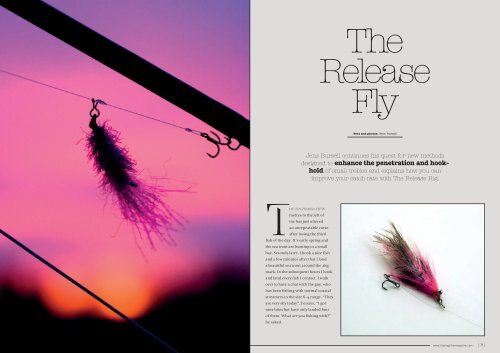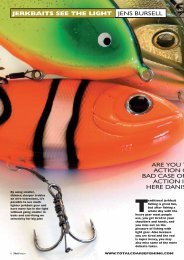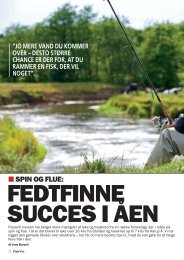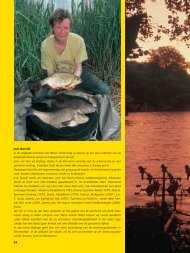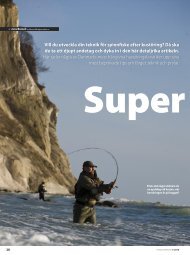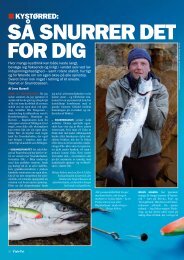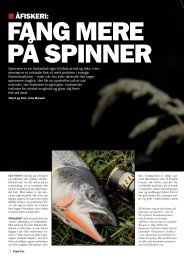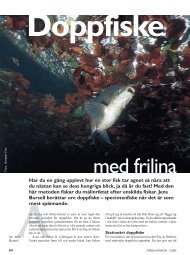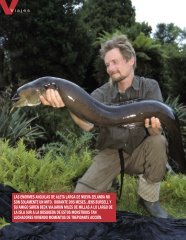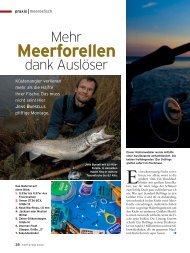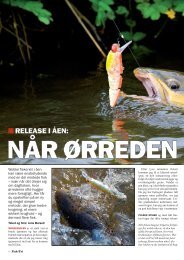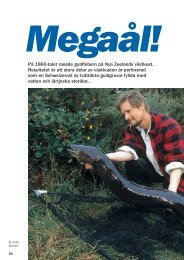Read article (pdf - 2480 KB) - Jens Bursell
Read article (pdf - 2480 KB) - Jens Bursell
Read article (pdf - 2480 KB) - Jens Bursell
- No tags were found...
You also want an ePaper? Increase the reach of your titles
YUMPU automatically turns print PDFs into web optimized ePapers that Google loves.
The<br />
Release<br />
Fly<br />
Text and photos: <strong>Jens</strong> <strong>Bursell</strong><br />
<strong>Jens</strong> <strong>Bursell</strong> continues his quest for new methods<br />
designed to enhance the penetration and hookhold<br />
of small trebles and explains how you can<br />
improve your catch rate with The Release Rig.<br />
The fly-fisher fifty<br />
metres to the left of<br />
me has just uttered<br />
an unrepeatable curse<br />
after losing the third<br />
fish of the day. It’s early spring and<br />
the sea trout are hunting in a small<br />
bay. Seconds later, I hook a nice fish<br />
and a few minutes after that I land<br />
a beautiful sea trout around the 2kg<br />
mark. In the subsequent hours I hook<br />
and land every fish I contact. I walk<br />
over to have a chat with the guy, who<br />
has been fishing with normal coastal<br />
streamers in the size 6-4 range. “They<br />
are very shy today”, he says, “I got<br />
nine bites but have only landed four<br />
of them. What are you fishing with”<br />
he asked.<br />
www.chasingsilvermagazine.com<br />
| 71 |
The Release Fly<br />
The Release Fly<br />
Negative leverageeffect<br />
on streamer<br />
Leverage on a<br />
tube fly<br />
The Release Rig<br />
In order to deal with bad penetration,<br />
leverage and poor hook holds, I<br />
developed a rig concept during 2007-<br />
10. The Release Rig was originally<br />
designed for pike fishing with hard<br />
baits, where it reduced losses from<br />
50% to 5-10%. After this I converted<br />
the system to coastal sea trout hard<br />
baits - where roughly 50% of all<br />
contacts are also lost. In the course<br />
of our experiments with The Release<br />
Rig, we caught about 350 sea trout on<br />
spinners, with a landing rate of 90-<br />
95%. The next step was to convert the<br />
same principles to fly fishing for sea<br />
trout.<br />
The Release Fly<br />
It’s easy to modify any fly to The<br />
Release Rig system. First, cut the<br />
hook point in the middle of the gape.<br />
The fly is mounted on The Release<br />
As it happens we have the same<br />
levered backwards out of the hook-<br />
compared than with streamers<br />
fly at the end of the tippet, but the<br />
hold. I believe that this, combined<br />
because the tube can slide up the<br />
crucial difference is my release rig.<br />
with the relatively bad penetration of<br />
tippet if/when released from the hook<br />
With a dataset of over 750 contacts<br />
streamers (see issue 3/2011), is the<br />
guard. Besides, many tube bodies<br />
(conventional streamer vs Release<br />
main reason why so many Danish sea<br />
are so soft that some of the leverage<br />
Fly) I can safely conclude, that my<br />
trout are lost.<br />
is absorbed by the material. But why<br />
success rate is no fluke.<br />
If leverage occurs with a tube<br />
not eliminate the negative effect<br />
The leverage effect is generally<br />
fly during striking, this has a positive<br />
completely<br />
accepted as having a negative effect<br />
effect on the penetration because the<br />
The smaller the hooks you use,<br />
on hook hold. I believe this is true<br />
leverage multiplies the pressure in<br />
and the larger the fish you target,<br />
in most situations, but not all. In<br />
the same direction as the hook point<br />
the more important it becomes to<br />
order to deal with the problem, it is<br />
penetrates. This means that leverage<br />
eliminate leverage as the hook is<br />
important to distinguish between<br />
at the second of striking actually helps<br />
under extreme pressure. In order<br />
different types of leverage.<br />
to set the hook. But when the barb has<br />
to realise the superior penetration<br />
penetrated fully, further leverage<br />
and hook-hold of very small hooks,<br />
Negative or<br />
positive leverage<br />
On a streamer, there is a high risk<br />
that the hook point/barb can be<br />
works negatively on the hook and it<br />
can be straightened or torn from the<br />
flesh.<br />
The negative impact of leverage<br />
on tube flies is often more moderate<br />
designing a 100% leverage free<br />
system makes good sense if you don’t<br />
want to lose the fish of your dreams.<br />
The Release Fly: In the split second before releasing the hook-link, the leverage<br />
works in the same direction as penetration, helping to set the hook.<br />
If leverage occurs the hook-link is<br />
released immediately, before it can<br />
negatively affect the hook-hold.<br />
| 72 |<br />
Chasing Silver Fly Fishing Magazine www.chasingsilvermagazine.com | 73 |
The Release Fly<br />
The Release Fly<br />
Rig with a fly-snapper and the<br />
treble dangles on the hook link in a<br />
blood loop under the end of the fly.<br />
The hook link is semi-fixed to the<br />
remaining part of the gape with a<br />
piece of silicone tubing. When a fish<br />
bites, the small treble will be released<br />
from the fly if any leverage occurs.<br />
When released, the fly can slide freely<br />
up the tippet.<br />
We have had great success with<br />
Owner ST 36 BCX size 16-18 trebles<br />
on Release Rig sea trout streamers<br />
and have landed around 90-95% of<br />
200 contacts with variations on this<br />
rig.<br />
Between 36 -62% of the<br />
contacts are lost during traditional<br />
streamer fishing (based on a survey<br />
of 534 contacts – see 3/2011), these<br />
rigs produce an improvement of<br />
the catch rate of 50-150%. Despite<br />
having caught over 550 sea trout up<br />
to 8.1kg on Release Rigs with small<br />
hooks in the size 12-18 range (spin<br />
+ fly), we have not experienced any<br />
breakages or other serious damage to<br />
the hook, thanks to the leverage-free<br />
construction of the rig.<br />
Leading link effect<br />
I am convinced that we get a lot of<br />
bites that don’t register. When the<br />
sea trout sucks in the fly and tries<br />
to blow it out, or perhaps snaps<br />
hesitantly after the fly, I believe that<br />
the dangling hook-link is an added<br />
bonus as it is easily caught behind<br />
the backwards facing teeth of the<br />
fish even if the mouth is not closed.<br />
If this happens simultaneously with<br />
the forward movement of the rig, the<br />
hook-link will slide behind the teeth<br />
and guide the hook to the jaw, helping<br />
to improve the catch rate.<br />
The Reloose Rig<br />
This is essentially a Release Rig that<br />
hangs loose under the bait. This<br />
simple variant works very well as long<br />
as you use small, sparsely dressed<br />
flies up to 3-4 centimetres in length,<br />
such as “Flammen”, “Juletræet”<br />
and “Bloody Butcher”. I have often<br />
doubled my landing rate with this set<br />
On The Reloose Rig the hook is mounted on a small rapala-loop. The positioning<br />
of the hook is adjusted by pushing the power gum stop knot along the tippet. The<br />
tippet can also be threaded directly through the eye of the hook.<br />
up, but one of my test anglers, Erik – but when switching to The Reloose<br />
Tveskov, experienced a three-fold Rig he lost only one of 21 contacts,<br />
improvement last autumn. During which is less than 5%. Another<br />
several trips to his local fjord with test angler, Karsten Bech, also<br />
the “Juletræet” fly tied onto a size 4 experienced a marked improvement<br />
streamer, he lost 2/3 of all contacts in his catch rate in his local Mariager<br />
<strong>Jens</strong> <strong>Bursell</strong> with a 6 kg+ sea trout<br />
caught on The Release Rig.<br />
The dangling hook link<br />
It might look odd, but based<br />
on our catches I can guarantee<br />
that the Release Rig does not<br />
impact negatively on casting or<br />
presentation, so long as you use a<br />
quality fluorocarbon tippet. You get<br />
exactly the same amount of bites,<br />
but you don’t lose as many fish. The<br />
asymmetric 100% free exposure of<br />
the small hook is a major part of the<br />
success of the Release Rig, but I also<br />
believe that the freely exposed hooklink<br />
has a positive effect on hooking.<br />
Potential<br />
for all species<br />
I<br />
have mainly been using<br />
The Release Rig for sea<br />
trout, rainbows and pike, but<br />
I am convinced it has great<br />
potential in many types of fly<br />
fishing with relatively large<br />
flies, for instance, salmon<br />
and tarpon fishing. I would<br />
not be surprised if it turned<br />
out that you could go from<br />
landing 10-20% on a big tarpon<br />
streamer to landing 90%<br />
with the same fly on a Release<br />
Rig and a size 6 treble.<br />
| 74 |<br />
Chasing Silver Fly Fishing Magazine www.chasingsilvermagazine.com | 75 |
The Release Fly<br />
The Release Fly<br />
Getting the<br />
friction right<br />
If the release tube (e) releases<br />
too often during fishing<br />
– you must add more friction.<br />
This can either be done by using<br />
a thinner diameter, a longer<br />
piece, or a slightly stiffer/<br />
thicker material. For streamers<br />
in the size 6-2 range<br />
0.5mm ESP Silicone Tubing is<br />
normally a good choice.<br />
On the stop-knot (d), friction<br />
is dictated by how tight<br />
you pull it and by how many<br />
turns you have in the knot.<br />
6-7 turns normally gives sufficient<br />
friction to avoid sliding<br />
during casting, but still allows<br />
you to move the knot forwards<br />
or backwards when adjusting<br />
the position of the<br />
hook, or the length of the<br />
hook link to fit different sizes<br />
of flies. 7 lb Gardner Power<br />
Gum (found in carp fishing<br />
shops) is ideal.<br />
Fjord. The set up was size 10-8 flies<br />
on a Reloose Rig with a size 18 Owner<br />
ST36 BCX.<br />
When you fish with this rig,<br />
it is important to cut the hook off<br />
close to the body of the fly because a<br />
protruding hook gape can mask the<br />
small hook, reducing its exposure and<br />
hooking potential.<br />
The anti-eject effect<br />
I believe an important part of the<br />
effectiveness of the Reloose Rig is<br />
that I have designed it to have what<br />
carp anglers would call an ‘anti-eject’<br />
effect. These types of rigs are much<br />
more difficult for the fish to blow out.<br />
They are designed for “suck & blow”<br />
foraging and I believe that many of<br />
the bonus fish you get with anti-ejectrigs<br />
are often fish you would not even<br />
have registered biting in the first<br />
place.<br />
If a fish tries to blow out a fly<br />
fished on The Reloose Rig – the fly<br />
slides up the tippet and the hook<br />
remains in the mouth. Sometimes<br />
the hook will be dragged<br />
with the fly, in which case<br />
the hook is dragged out<br />
with the points pointing<br />
forwards, thereby enhancing<br />
the chances that they will<br />
get a grip on the inside of<br />
the jaw on the way out. The<br />
same effect, although not as<br />
pronounced, is obtained on<br />
L-rigs and Release Rigs. Here<br />
the asymmetric construction,<br />
combined with the loosely<br />
dangling hook and “leading<br />
link effect”, will also enhance<br />
the chances of the hook<br />
getting a grip on the way<br />
out. I believe that if a fish<br />
tries to blow out a normal<br />
streamer, the risk that it will<br />
be successful is much higher.<br />
Make a<br />
good start<br />
Step<br />
1 – Make a 20-30o cut at the top<br />
of 3-4 mm free tube protruding in the<br />
end with a scalpel. Heat a needle and<br />
melt a hole where the fly-snapper can<br />
be mounted.<br />
Release Rig<br />
with tube flies<br />
Step<br />
2 – The tube is cut and a hole<br />
melted in the same way in the rear end<br />
of the tube – and with a scalpel you<br />
cut a crack from the end of the tube<br />
into the hole. The hook link is semifixed<br />
by pushing the end of it through<br />
the crack. The knot at the end of the<br />
tippet prevents it from releasing during<br />
casting and the retrieve.<br />
Similarity with<br />
The Needle Fly<br />
Some might think that The<br />
Release Rig has similarities<br />
with The Needle Fly, but<br />
the functionality is completely<br />
different. On The Release<br />
Rig the hook is released easily<br />
before leverage can work<br />
negatively on the hook hold,<br />
because the soft tube is “parallel”<br />
to the direction of pull<br />
if leverage occurs. On a Needle<br />
Fly, the hard PVC tube is<br />
perpendicular to the direction<br />
of leverage pull, and the tube<br />
will be pushed back tightly<br />
against the “needle stop”, instead<br />
of releasing the hook if<br />
leverage occurs.<br />
If you decide to use this<br />
method, it is important to be<br />
patient and allow yourself<br />
plenty of time to learn to tie<br />
the knots and to fish the rig<br />
correctly. It might take some<br />
time to get used to it. In the<br />
beginning it is important<br />
to check the fly often to be<br />
100% sure that you have<br />
adjusted the rig correctly.<br />
This helps to ensure that<br />
it does not tangle and the<br />
hook-link does not release<br />
by mistake. <strong>Read</strong> more at<br />
www.bursell.dk in the <strong>article</strong><br />
‘The Release Fly – extra tips’.<br />
Good luck! ■<br />
Step<br />
3 – <strong>Read</strong>y to fish. An interesting thing with the cut at the end of the fly is that<br />
it works a bit like a wobler spoon, which makes the fly dive. This means that you also<br />
could choose to turn it upside down – and the cut will make the fly rise in the water.<br />
| 76 | Chasing Silver Fly Fishing Magazine www.chasingsilvermagazine.com | 77 |
April’s The Release Fav Five Fly<br />
April’s The Release Fav Five Fly<br />
10-20% on a big tarpon streamer to<br />
Release<br />
Rig for<br />
hook flies<br />
landing 90% with the same fly on a<br />
Release Rig and a size 6 treble.<br />
BOX END<br />
Release Rig for hook flies:<br />
Cut the hook point off with<br />
pliers in the middle of the gape and<br />
Step<br />
1 – Cut the hook point off with<br />
pliers in the middle of the gape and<br />
grind the sharp edges off with an emery<br />
cloth.<br />
Step<br />
2 – Mount a size 2-3 fly-snapper<br />
(a) - here a Mustad 77145 size 2-3 – on<br />
the tippet. The opening must turn in the<br />
direction of the fly in order to minimise<br />
the risk of catching weed during the<br />
retrieve.<br />
Step<br />
3 – Tie the small treble into a<br />
blood loop (b). Put the tippet through<br />
the eye as shown. Turning the hook this<br />
way instead of 180o degrees opposite<br />
gives better penetration and maximum<br />
depth of grip – read why at www.<br />
bursell.dk in the <strong>article</strong> “Release Fly –<br />
Optimise Penetration & Hookhold”.<br />
Step<br />
4 – Take the end of the tippet<br />
and wrap five turns round the tippet.<br />
Step grind the sharp edges off with an<br />
5 – Open the middle turn with<br />
emery cloth.<br />
your thumbnail and push the hook<br />
through. Wet the knot and tighten<br />
gradually while you adjust the length of<br />
the loop Mount to 2-3 a mm. size 2-3 The fly-snapper<br />
hook must be<br />
able (a) to - here dangle a Mustad freely. 77145 size 2-3 – on<br />
the tippet. The opening must turn in the<br />
direction of the fly in order to minimise<br />
the risk of catching weed during the<br />
retrieve.<br />
Tie the small treble into a blood<br />
loop (b). Put the tippet through the eye<br />
as shown. Turning the hook this way<br />
instead of 180 o degrees opposite gives<br />
better penetration and maximum depth<br />
of grip – read why at www.bursell.dk<br />
in the <strong>article</strong> “Release Fly – Optimise<br />
Penetration & Hookhold”.<br />
BOX END<br />
BOX<br />
Similarity with The Needle Fly<br />
Some might think that The<br />
Release Rig has similarities with The<br />
Needle Fly, but the functionality is<br />
completely different. On The Release<br />
Rig the hook is released easily before<br />
leverage can work negatively on the<br />
hook hold, because the soft tube is<br />
“parallel” to the direction of pull if<br />
leverage occurs. On a Needle Fly,<br />
Step<br />
6 – The blood loop. Do not cut<br />
the end of the tippet (c) off.<br />
the tube will be pushed back tightly<br />
against the “needle stop”, instead of<br />
releasing the hook if leverage occurs.<br />
BOX END<br />
BOX<br />
Potential for all species<br />
I have mainly been using The<br />
Release Rig for sea trout, rainbows<br />
and pike, but I am convinced it has<br />
great potential in many types of fly<br />
fishing with relatively large flies, for<br />
instance, salmon and tarpon fishing.<br />
Step<br />
7 – Take 10-15 cm of elastic<br />
power gum and tie a stop knot with 6-7<br />
turns (d) between the blood loop and<br />
the fly-snapper. Tighten well.<br />
Step<br />
8 – Cut off 3-4 mm silicone<br />
tube (e) and thread it at the end of the<br />
tippet (c). Tie a granny knot (f), which<br />
works as a contra stop, so that the hook<br />
link does not release too easily during<br />
fishing. The knot (f), which ensures<br />
that the tube rarely falls off during<br />
release, must be 1-1.3 cm from the<br />
blood loop (b). Cut the tippet (c) 5-6<br />
mm over the granny knot. If the tube<br />
falls off by mistake during fishing, the<br />
extra 5-6 mm (g) make it easy to thread<br />
it again. Push the tube over the end<br />
of (g), hold the protruding end of the<br />
tippet with your teeth – and drag the<br />
tube back down over the knot (f).<br />
Step<br />
9 – Lock the fly-snapper (a)<br />
with a small pean (h) and mount the fly<br />
in the front end.<br />
Step<br />
10 – Push the rear end of the<br />
hook link with the tube (c + e + g) over<br />
the hook Take gape. the Adjust end of the positioning tippet and of<br />
the wrap hook five so turns it dangles round just the under tippet. the fly.<br />
The hook must hang under the broken<br />
line when the fly is held horizontally.<br />
The tippet, from the stop knot (d) to the<br />
Open the middle turn with<br />
blood loop (b), must not bow under the<br />
broken<br />
your thumbnail<br />
line. When<br />
and<br />
The<br />
push<br />
Release<br />
the<br />
Rig<br />
hook<br />
is<br />
seen through. from behind, Wet the the knot blood and loop tighten must<br />
hang gradually vertically. while If this you adjust is not the case, length<br />
twist of the loop rear to end 2-3 of mm. the tippet The hook (c + must e +<br />
g) be around able to its dangle own axis freely. until the hook is<br />
hanging correctly. Adjust the rig at the<br />
arrows.<br />
The blood loop. Do not cut the end<br />
the hard PVC tube is perpendicular<br />
I would not be surprised if it turned<br />
of the tippet (c) off.<br />
to the direction of leverage pull, and<br />
out that you could go from landing<br />
| 78 | Chasing Silver Fly Fishing Magazine www.chasingsilvermagazine.com<br />
| 79 |


